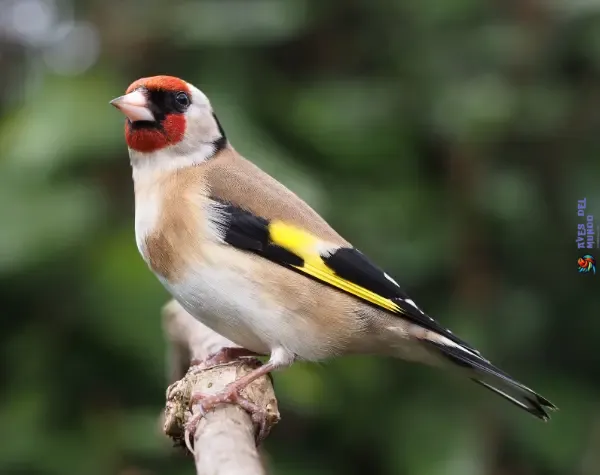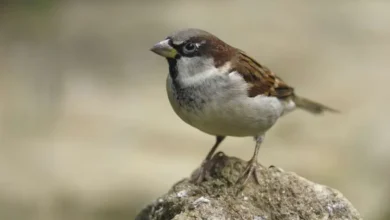Yellow birds are some of the most visually striking and fascinating avian species found across the globe. Their bright plumage not only adds a splash of color to their habitats but also serves various biological purposes. In this blog, we’ll explore 15 different species of yellow birds, diving into their unique characteristics, habitats, behaviors, and the roles they play in our ecosystems.

- 1. Canary
- 2. European Goldfinch
- 3. European Greenfinch
- 4. Wild Canary
- 5. Yellow Tanager
- 6. Lemon Tanager
- 7. Golden Tanager
- 8. Scarlet Tanager
- 9. Golden-winged Tanager
- 10. Golden-throated Barbet
- 11. Yellow-headed Tanager
- 12. Saffron Finch
- 13. Yellow Warbler
- 14. American Goldfinch
- 15. Western Yellow Wagtail
1. Canary
- Appearance: Canaries are small, bright yellow birds, although they can also come in white, orange, and brown varieties due to selective breeding.
- Habitat: Native to the Canary Islands, Azores, and Madeira.

Behavior and Traits
Canaries are famous for their singing abilities, which have made them popular pets for centuries. In the wild, they inhabit forests, gardens, and orchards. These birds are social and thrive in small flocks. Male canaries are particularly known for their melodious and complex songs, which they use to attract mates and mark their territory.
Conservation Status
Wild canaries have a stable population, but habitat destruction poses a potential threat. Conservation efforts focus on preserving their natural habitats and regulating the pet trade to prevent over-exploitation.
2. European Goldfinch
- Appearance: The European Goldfinch has a striking red face, black and white head, and bright yellow wing bars.
- Habitat: Found across Europe, North Africa, and Western Asia.

Behavior and Traits
These birds are easily recognizable by their vibrant plumage and delightful, tinkling song. They prefer open, lightly wooded areas, gardens, and orchards. European Goldfinches are known for their acrobatic feeding habits, often seen clinging to thistle heads and other plants to extract seeds.
Conservation Status
The European Goldfinch is not currently at risk, thanks to its adaptability to different habitats and food sources. Conservation efforts ensure that their habitats remain undisturbed and that populations remain healthy.
3. European Greenfinch
- Appearance: The European Greenfinch boasts a yellow-green plumage with brighter yellow patches on the wings and tail.
- Habitat: Found across Europe, North Africa, and Southwestern Asia.

Behavior and Traits
Greenfinches are robust birds that prefer woodland edges, gardens, and hedgerows. They have a varied diet that includes seeds, berries, and insects. These birds are also known for their wheezy, twittering songs and their propensity to visit garden feeders, especially during the winter months.
Conservation Status
While generally abundant, European Greenfinch populations have experienced declines in some areas due to habitat loss and diseases like trichomonosis. Conservation measures include monitoring disease outbreaks and protecting their natural habitats.
4. Wild Canary
- Appearance: Wild Canaries, also known as Island Canaries, are primarily yellow-green with more subdued, earthy tones compared to domesticated canaries.
- Habitat: Native to the Canary Islands, Azores, and Madeira.

Behavior and Traits
Wild Canaries are social birds that live in flocks. They inhabit various environments, including forests, gardens, and cultivated areas. Their diet consists mainly of seeds, fruits, and insects. Unlike their domesticated counterparts, wild canaries are less dependent on human-provided food sources and retain more natural behaviors.
Conservation Status
These birds are generally considered to be of least concern, but habitat preservation is essential to maintain their populations, particularly on the islands where they are native.
5. Yellow Tanager
- Appearance: Yellow Tanagers are small birds with bright yellow plumage and a distinctive black eye mask.
- Habitat: Found in Central and South America, particularly in tropical and subtropical forests.

Behavior and Traits
Yellow Tanagers are active and social, often seen flitting through the forest canopy in search of insects and fruit. Their bright coloration makes them easily visible, and they play an important role in the ecosystems as pollinators and seed dispersers.
Conservation Status
The Yellow Tanager’s population is currently stable, but deforestation and habitat fragmentation pose significant threats. Conservation efforts focus on protecting tropical forest habitats and promoting sustainable land use practices.
6. Lemon Tanager
Description
- Appearance: Lemon Tanagers are medium-sized birds with vivid yellow plumage and olive-green backs.
- Habitat: Native to South America, found in tropical rainforests and secondary forests.
Behavior and Traits
These birds are often seen in pairs or small groups, foraging for insects and fruit in the forest canopy. They have a sweet, melodic song and are known for their agility and quick movements among the foliage.
Conservation Status
Lemon Tanagers are not currently endangered, but ongoing deforestation in the Amazon basin could threaten their habitat. Conservation strategies include protecting large areas of rainforest and restoring degraded habitats.
7. Golden Tanager
Description
- Appearance: Golden Tanagers are striking birds with golden-yellow plumage and black markings on the wings and back.
- Habitat: Found in the montane forests of the Andes in South America.
Behavior and Traits
Golden Tanagers are highly social and often form mixed-species flocks. They feed on insects, fruit, and nectar, contributing to pollination and seed dispersal in their habitats. Their bright colors and active behavior make them a delight to observe.
Conservation Status
Their population is relatively stable, but habitat loss due to agriculture and mining poses a risk. Conservation efforts aim to protect Andean forests and promote sustainable agricultural practices.
8. Scarlet Tanager
Description
- Appearance: Scarlet Tanagers have a bright red body with contrasting black wings and tail in males, while females are yellow with olive wings.
- Habitat: Breeds in deciduous forests in North America and migrates to South America for the winter.
Behavior and Traits
Scarlet Tanagers are known for their striking coloration and beautiful, flute-like song. They prefer to stay high in the forest canopy, making them more often heard than seen. These birds are insectivorous during the breeding season and switch to a diet rich in fruit during migration and winter.
Conservation Status
Although not currently endangered, Scarlet Tanagers face threats from habitat destruction and climate change. Conservation efforts include protecting forest habitats in both their breeding and wintering ranges.
9. Golden-winged Tanager
Description
- Appearance: Golden-winged Tanagers are adorned with blue-gray plumage, bright golden-yellow wings, and a distinctive golden cap.
- Habitat: Found in humid forests and forest edges in Central and South America.
Behavior and Traits
These tanagers are active and social, often seen in mixed-species flocks. They feed primarily on insects and fruit, playing a vital role in maintaining the health of their ecosystems. Their colorful appearance and dynamic behavior make them popular among birdwatchers.
Conservation Status
Golden-winged Tanagers are facing habitat loss due to deforestation and land conversion. Conservation efforts focus on preserving forest habitats and promoting reforestation projects.
10. Golden-throated Barbet
Description
- Appearance: The Golden-throated Barbet has a distinctive golden throat, green body, and blue and red markings on its head.
- Habitat: Inhabits tropical and subtropical forests in Southeast Asia.
Behavior and Traits
These birds are known for their strong, resonant calls and their habit of excavating nest cavities in trees. They feed on fruit, insects, and small vertebrates. Their striking appearance and vocalizations make them a key species in their habitats.
Conservation Status
Golden-throated Barbets are not currently endangered, but habitat destruction poses a significant threat. Conservation strategies include protecting forest habitats and curbing illegal logging activities.
11. Yellow-headed Tanager
Description
- Appearance: Yellow-headed Tanagers have bright yellow heads, olive-green backs, and grayish underparts.
- Habitat: Found in tropical and subtropical forests in South America.
Behavior and Traits
These tanagers are often seen in the mid-canopy, foraging for insects and fruit. They are social birds, frequently joining mixed-species flocks. Their bright coloration and active behavior make them a favorite among birdwatchers.
Conservation Status
While not currently at risk, Yellow-headed Tanagers are vulnerable to habitat loss. Conservation efforts focus on protecting and restoring their forest habitats.
12. Saffron Finch
Description
- Appearance: Saffron Finches have bright yellow plumage with slight orange tints on their heads.
- Habitat: Native to South America, commonly found in open and semi-open areas, including gardens and farmland.
Behavior and Traits
These finches are highly adaptable, thriving in both urban and rural settings. They have a cheerful song and are often seen in flocks. Saffron Finches feed on seeds, grains, and insects, making them important for pest control and seed dispersal.
Conservation Status
Saffron Finches are abundant and not currently at risk. However, maintaining their habitats and preventing the spread of diseases are crucial for their continued well-being.
13. Yellow Warbler
Description
- Appearance: Yellow Warblers are small, vibrant yellow birds with subtle reddish streaks on their breasts.
- Habitat: Found throughout North and South America, in a variety of habitats including wetlands, forests, and gardens.
Behavior and Traits
These warblers are highly migratory, traveling long distances between their breeding and wintering grounds. They have a sweet, musical song and are often seen flitting through shrubs and trees in search of
insects. Yellow Warblers play a crucial role in controlling insect populations.
Conservation Status
Yellow Warblers face threats from habitat destruction and climate change. Conservation efforts include protecting critical habitats and ensuring safe migration routes.
14. American Goldfinch
Description
- Appearance: Male American Goldfinches are bright yellow with black wings and a black cap, while females are more subdued in olive-yellow.
- Habitat: Common in open fields, meadows, and gardens across North America.
Behavior and Traits
American Goldfinches are known for their undulating flight pattern and cheerful, twittering song. They feed primarily on seeds and are often seen at bird feeders. These finches undergo a complete molt in late summer, which is unusual among songbirds.
Conservation Status
The American Goldfinch is not currently at risk, but habitat preservation is important to maintain healthy populations. Conservation measures include promoting native plant growth and protecting open fields.
15. Western Yellow Wagtail
Description
- Appearance: Western Yellow Wagtails have bright yellow underparts and olive-green upperparts, with some variation in head coloration depending on the subspecies.
- Habitat: Found across Europe, Asia, and Africa, in open habitats such as grasslands and wetlands.
Behavior and Traits
These birds are highly migratory, moving between breeding grounds in Europe and Asia and wintering areas in Africa. They are known for their distinctive wagging tail behavior, which is thought to be a signal to other birds. Western Yellow Wagtails feed on insects and are often seen foraging on the ground or near water.
Conservation Status
While generally abundant, Western Yellow Wagtails face threats from habitat loss and changes in agricultural practices. Conservation efforts focus on preserving wetland habitats and promoting sustainable farming practices.
Conclusion
Yellow birds are a diverse and fascinating group, each species bringing its unique charm and ecological significance to their habitats. From the melodious Canary to the striking American Goldfinch, these birds captivate birdwatchers and nature enthusiasts alike. Conservation efforts are crucial to ensure that these vibrant species continue to thrive, preserving the beauty and biodiversity of our natural world. By understanding and appreciating these yellow-feathered friends, we can foster a deeper connection to nature and support the preservation of their habitats for future generations. Happy birdwatching!



